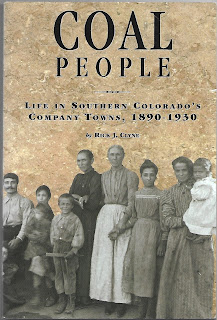 |
| Book Cover, Photo by The Colorado Historical Society & Rick J. Clyne (All Rights Reserved) |
Clyne, Rick J. Coal People Life in Southern Colorado's Company Towns, 1890-1930 (Denver, CO, Colorado Historical Society, 1999)
This little book has been one of the most pleasant and informative things I have read in quite some time. It began as a masters thesis in history for the author, Rick J. Clyne, when he was a graduate student at The University of Colorado at Denver. He states that he turned the thesis into this book upon the urging of some of his professors and the Colorado Historical Society which published the book. It covers a forty year period from 1890 to 1930 in the coal fields of Colorado and is based primarily on information which the author gained from oral history records at the Colorado Coal Project and at the Huerfano County Ethno-History Project. The photographs in the book are wonderful and wonderfully informative about coal camp life at the turn of the twentieth century. With that said, I have chosen to scan the book cover with its relatively generic photo of an extended family or group of people in one of the camps. The other photograph I am including in this review is one of a group of young boys who are either going to work or leaving the mine in one of those camps. That photo is not labeled as to the site at which it was taken. But it is one of the most telling photographs of child labor in America that I have ever seen. The photo is printed in the book over two pages and does not scan well but it is still graphic, memorable, and somewhat shocking to see. The photograph shows eight juvenile coal miners whose ages likely range for eight or nine to about fourteen. They look tired and far too old before their time. One of the boys appears to have some sort of genetic based facial conformity which might indicate either fetal alcohol syndrome or an intellectual impairment. Remember that the author of the book, Rick J. Clyne, and the Colorado Historical Society own all the rights to these photographs and they are fully protected under US Copyright Law. Do not duplicate, copy, scan or use these two photographs in any manner without the express written permission of Rick J. Clyne and/or the Colorado Historical Society.
 |
| Juvenile Miners In Colorado--Photo by The Colorado Historical Society and Rick J. Clyne, (All Rights Reserved) |
The book focuses on coal camps in Huerfano and Las Animas counties in Colorado and that area includes the site of the Ludlow Massacre, one of the most horrendous events in all the history of coal mining in America. Clyne gives credit to a visit to the UMWA built memorial to the dead at Ludlow for sparking his interest in the coal camps of the region. The book is composed of a preface, an acknowledgements section, and seven chapters. It is only 102 pages of primary of text without the index and notes. But those 102 pages are incredibly well worth reading for the person who is interested in coal camp life, coal mining, Colorado history, the UMWA, immigration, or company towns. The author did a commendable job of converting what appears to have been a more academically focused masters thesis into a readable book for the casual student of history or coal camp life. The seven chapters are labeled Coalfields, Companies, and Unions; The Company Town; The Community; A Miner's Life; A Woman's Life; A Child's Life; and Conclusion. Each of those chapters addresses a key component of life in a company town in the coalfields. Clyne leaned heavily on those first person oral history accounts and that was an excellent choice. No history is better than oral history provided by the people who lived it. But noticeably absent is any sizable input from company officials, company police, or strike breakers. The author also, in my opinion, attempted to be just a bit too generous toward the companies in his discussion of labor unrest, child labor, or other conflicts except those which occurred between different ethnic groups.
But, this is an excellent book and well worth reading if you are interested in coal mining history in America or Colorado. Its positive qualities far outweigh the deficiencies I have noted above. Since it is from a small publisher or regional history, it is likely that it was published in a small printing and may be difficult to find other than on website of used books. But it will be worth the effort.
No comments:
Post a Comment